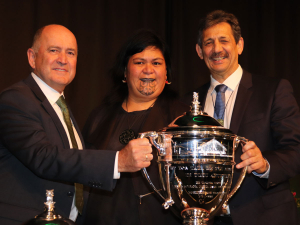Roadmap set to double hort exports by 2035
It's critical that the horticulture sector works together as part of a goal to double the sector’s exports by 2035.
 Hort NZ chair Barry O’Neill; Māori Development Minister Nania Mahuta and Ahuwhenua Trophy committee chair Kingi Smiler at the unveiling of the new hort trophy at last year’s Hort NZ conference.
Hort NZ chair Barry O’Neill; Māori Development Minister Nania Mahuta and Ahuwhenua Trophy committee chair Kingi Smiler at the unveiling of the new hort trophy at last year’s Hort NZ conference.
Three vastly different kiwifruit orchards make up the finalists in the inaugural Ahuwhenua Trophy competition for the top horticultural enterprise in the country.
The finalists were announced at a function at Parliament recently by the Minister for Māori Development, the Nanaia Mahuta and attended by politicians, diplomats, agribusiness and Maori leaders and
The three finalists are:
Hineora Orchard, Te Kaha 15B Ahu Whenua Trust, a small kiwifruit block located in the Eastern Bay of Plenty township of Te Kaha, 65km east of Ōpōtiki.
Otama Marere at Paengaroa, near the Bay of Plenty town of Te Puke, which grow a mixture of Green, SunGold and organic kiwifruit as well as avocados.
Ngai Tukairangi Trust, which is a large kiwifruit operation with one of its orchards, based at Matapihi, just a few kilometres from the centre of Tauranga city.
This is the first time in the 87-year history of the competition that the trophy has been open to horticulturalists. Previously it’s been restricted to sheep and beef and dairy farmers. However, a new trophy, similar to the other two has been manufactured and will be presented to the winner at an awards function in Tauranga at the end of May.
The Ahuwhenua Trophy is the most prestigious award for excellence in Māori farming and was inaugurated 87 years ago by the visionary Māori leader, Sir Apirana Ngata and the Governor General at the time, Lord Bledisloe. The objective is to encourage Māori farmers to improve their land and their overall farming position with an emphasis on sustainability.
On a three-year rotational basis, the trophy is competed for by Māori farmers in the sheep and beef, horticulture and dairy sectors.
Chairman of the Ahuwhenua Trophy management committee, Kingi Smiler, which organises the competition, says it is exciting to see such a positive response from Māori in the horticultural sector. He says the high calibre of all the entrants – in particular the finalists – highlights the contribution that Māori are making in the sector.
Smiler says in the last 20 years, the horticulture sector in New Zealand has become one of the stars of the New Zealand primary sector economy and it is pleasing to see that Māori have been an integral part of that growth.
“Since the inception of this competition we have seen what our sheep and beef and dairy farmers can do and now it is great to have the opportunity to showcase the excellence of our horticulturalists,” he told Hort News.
Smiler says while the sector is now basking in its success, the industry has been through hard times – especially the kiwifruit sector, which had to deal with PSA which significantly impacted on the industry.
“What we see in our finalists in 2020 is a unique combination of vision, resilience, innovation good governance, smart management and a commitment to their people,” he says. “They should be proud of their achievements and we are proud of them.”
Red meat farmers and processors are welcoming a US Government announcement - removing its reciprocal tariffs on a range of food products, including New Zealand beef.
OPINION: As negotiations advance on the India-New Zealand FTA, it’s important to remember the joint commitment made by Indian Prime Minister Narendra Modi and New Zealand Prime Minister Christopher Luxon at the beginning of this process in March: for a balanced, ambitious, comprehensive, and mutually beneficial agreement.
Minister for Universities, Shane Reti, has opened the final new build in a ten plus year project to upgrade the veterinary facilities at Massey University.
As New Zealand experiences more frequent and severe flooding events, the Insurance & Financial Services Ombudsman Scheme (IFSO Scheme) is urging consumers to be honest and accurate when making insurance claims for flood damage.
A recently held arable field day in the Manawatu brought with it a timely reminder to be on the lookout for velvetleaf incursions.
In a significant shift for employers, wage theft is no longer only a civil matter but now also a criminal one.